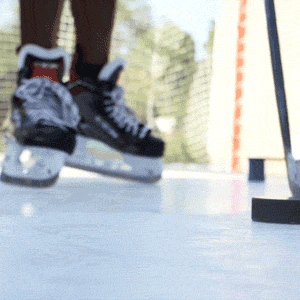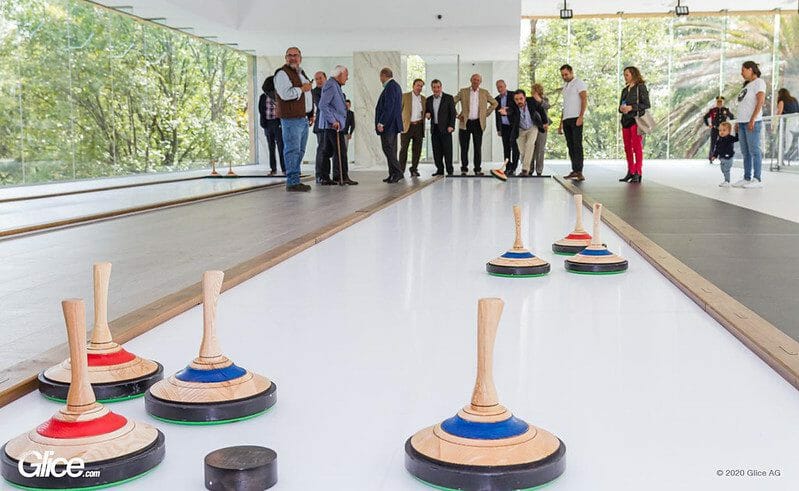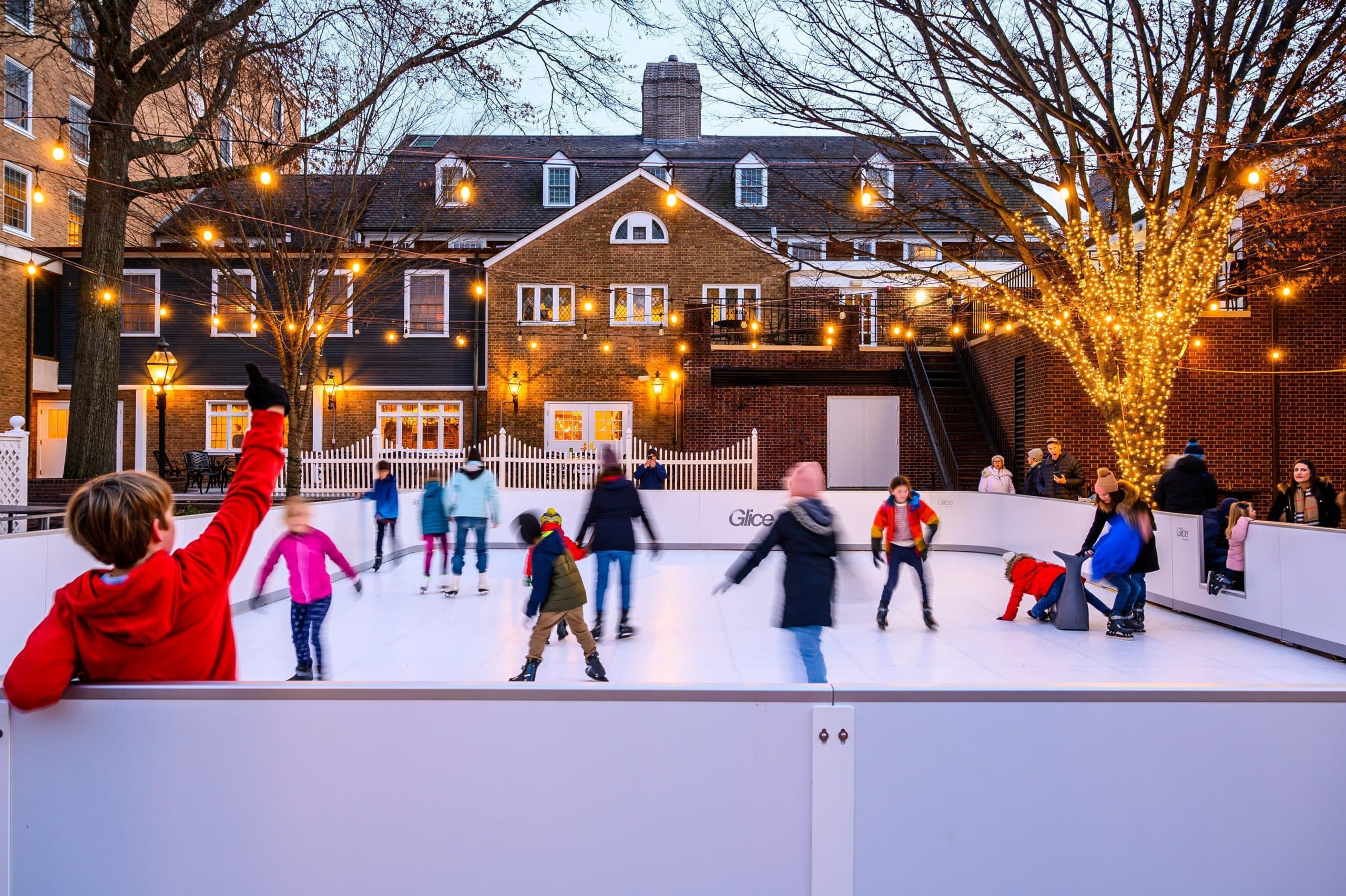Imagine owning a modern ice rink that doesn’t need water, power, coolants, bulky equipment, or even a Zamboni. It’s just as smooth as real ice, giving you an incredible glide. You can skate on it all day without having to stop for resurfacing.
Sounds like a dream, doesn’t it? Stop pinching yourself. The real thing is here!
If you’re new to the concept of synthetic or artificial ice, you’re in the right place. This guide will answer all your questions. We’ll explain what synthetic ice is, what it’s made of, what it’s like to skate on, and more.
What Is Synthetic Ice?
Synthetic ice—also referred to as fake ice rink material, or artificial, pretend, or imitation ice—is a fantastic alternative to traditional ice, that offers a smooth and seamless skating experience. Though nothing can compare to the real thing, Glice comes as close as it gets.
The experience of gliding on a superior synthetic ice rink gives skaters the feeling that they are gliding on impeccably smooth frozen water. The latest synthetic ice products have the most advanced technology that the skating industry has seen in decades.
Synthetic ice has become so popular, you can find thousands of Glice’s indoor and outdoor rinks in 100+ countries around the world. Resorts, entertainment venues, municipalities, and the like, are all enjoying the major benefits of synthetic ice over traditional ice. The technology today even allows for individuals to install a garage hockey rink at home.

What Is Artificial Ice Made Of?
Synthetic ice is made from a high-density polymer (polyethene plastic) specifically engineered for ice-skating. The material is molded into tiles and treated, resulting in a surface that simulates the sliding properties of traditional ice.
Depending on the manufacturer, different types of lubricants are added to the material to allow for a smooth glide. They can either be sprayed on the surface of the tiles or mixed directly into the polymer material during the manufacturing stage.
While those who are unfamiliar with the concept often ask, “Does synthetic ice melt?” but, given the superior plastics used to manufacture Glice, it’s clear that melting is not something you have to worry about when investing in a synthetic ice rink.
How Is It Manufactured?
Synthetic ice manufacturers use one of two processes to turn plastic polymer into skating material: extrusion and sintering.
- Extrusion pushes melted plastic through a nozzle and then leaves it to cool. The extrusion process isn’t easily controlled, creating inconsistencies in the finished surface.
- Sintering crushes plastic pellets under high pressure and controlled heat. This assures that lubricants are evenly mixed throughout, creating a perfectly plumb surface.

Why Is the Sintering Process Better?
In our opinion sintering is the far superior manufacturing process, and the one we use at Glice.
While it is a more expensive technique, it is by far the preferred choice due to the strength of the final product and the ultra-smooth surface achieved by the controlled heat and even pressure.
Sintering allows for lubricant pellets to be added into the polymer and mixed evenly throughout, providing a far superior glide. The extrusion process does not allow for the uniform disbursement of lubricants, leaving surfaces patchy and less cohesive throughout your skating glide.
Yet, despite the unbeatable finish, only a handful of artificial ice manufacturers in the world use this process—Glice being one of them. Our state-of-the-art manufacturing facility is the only one of its kind, providing a highly controlled environment that ensures the ideal temperature, humidity, and cleanliness necessary to produce the finest synthetic ice rinks in the world.
For this reason, our superior quality synthetic rinks are the number one choice for several Hockey Elite Training Centers (including CCM’s own test facility), and the world’s largest synthetic rink in Zócalo, Mexico City.
How Durable Is Synthetic Ice?
With such a wide range of synthetic ice qualities available (and more and more cheap synthetic ice options arriving on the market), it’s important to do your homework and fully understand what you are purchasing. Find out what can be done on the rink, where it can be installed, and how long your synthetic rink will last.
When it comes to synthetic ice rinks, you absolutely get what you pay for. Skimping on quality can result in you having to purchase multiple rinks over time. The level of quality ultimately depends on a few factors.
For example, does the plastic go through a sintering or extrusion process? How the connection system is designed and the thickness of the sheets are also of consequence, as they will determine how flat a rink lies and whether the edges or corners will lift or buckle.
With Glice, not only is our connection system the best in the industry, but our commercial synthetic sheets are so durable you can park your car on top of them!
What Is Artificial Ice Like to Skate On?
If you’re wondering how synthetic ice compares to real ice, you’ll be amazed after first pushing off onto a high-quality synthetic surface. Though it feels slightly different than real ice, you’ll quickly adapt to the change, completely forgetting that you are skating on ultra-slick plastic.

There is a fine line between creating a slick surface, yet allowing for enough friction to enable you to stop, change course, and show off your maneuvers.
Manufacturers over the years have worked on designing the optimal skating surface. However, the quality of the glide does differ between them. Having spent years on scientific research and testing to develop the most superior product, Glice offers the closest comparison.
While some require a topical lubricant to be regularly applied, higher-end products like Glice are designed to release the lubricants from within the product as you skate. This process gives you an incredible glide that is undeniably top notch.
Glice imbeds the lubricants deeply and evenly within each sheet, providing the ultimate glide to be found in synthetic ice today. Blades cut into the plastic (just like they cut into ice), releasing the emollients onto the surface. This unique design of releasing lubricants as your blades cut into the surface improves over time. The more you skate, the better your experience.
What Does Synthetic Ice Look Like After You Skate?
Imagine a plastic cutting board with little hairline scratches left over the surface from your sharp knife. This is similar to what you’ll see on synthetic ice after it’s been used. Glice synthetic rinks are specifically designed to allow your skates to lightly scratch open the surface, thereby releasing additional gliding lubrication.
This trait is unique to Glice; it’s a process that took years of research to devise and perfect. The extremely light scratches are just deep enough to help improve the surface every time you skate. This in turn improves your skating experience! The fine scratches on a Glice rink are a sign that our system is working. And the only difference you’ll notice in your glide is that it gets better and smoother the more you practice.
What Are the Benefits of Artificial Ice?
Synthetic ice looks and feels like real ice, while offering multiple benefits that will save you a considerable amount of cash and time. Synthetic ice is an all-season product that allows you to skate year round, no matter the weather!
Having your own rink at home allows you to skate whenever you want, giving you a competitive edge over others in your sport. There is no traveling to and from rental facilities and paying by the hour. There is no down time during practice, while you wait for the Zamboni to recondition the ice.
You won’t have to worry about special equipment, exorbitant electric bills, coolants or loud compressors. Praying for cold weather and wasting water will also become a thing of the past. Your skates will need to be sharpened a little more often, but your expensive boots and blades will be kept dry. No more rusting blades and eroding leather—another added plus!
Further reading: Is Synthetic Ice Bad for Skates?
Who Can Skate on Synthetic Ice?
Hockey/goaltending, figure skating, leisure skating, and even sports like Eisstock curling are all common uses for synthetic ice. You can do everything on artificial ice that you can on real ice.
The only move we discourage is toe-pick jumping while figure skating. Toe picks dig into the plastic and leave deep dings, making it challenging to repair.
Other than that, everything you can do on real ice is free game.

Installation and Design: What’s the Process?
Start with a flat surface and simply place your synthetic sheets in place. Setup is simple and fast, since all sheets are assembled by a connection system. It’s worth noting that manufacturers differ in the design of connectors, which makes a remarkable difference in your glide.
When you are looking to purchase a synthetic ice rink, be sure to choose a product that has a tight tongue-and-groove system (like Glice offers) to prevent lifting or shifting. A simple puzzle piece system will not offer you the seamless skating experience you’re expecting.
Glice’s tongue-and-groove and Smart Lock system prevents unnecessary trips and falls. The lack of noticeable grooves (thanks to the tight connection) also prevents dirt and debris from collecting in-between the panels.
Synthetic Ice Rink Maintenance
Safety and maintenance are two important factors any skater should consider before choosing a rink. While many artificial rink products differ in their maintenance guidelines, the overall requirements are essentially the same.
- Vacuuming regularly
- Mopping and conditioning occasionally
- Power washing annually
These are the three common honey-dos on the list. That’s it! Synthetic rinks are a far cry from the required maintenance of traditional ice skating rinks. Of course, make sure you understand the exact procedures of your rink depending on the product you choose.
Rink and Pad Sizes: How Much Do You Need?
A few sheets are a great start for beginning goaltenders (13×9 ft). If you have the yard space, you can even build your very own NHL-sized hockey rink, complete with ice markings and dasher boards.
The Glice rink in Zócalo, Mexico City is the largest synthetic ice rink in the world, spanning a whopping 43,000 square feet! The size and shape of your rink is entirely up to you.
Get in Touch to Learn More
When choosing a Glice rink, you are likely choosing the only brand you’ll ever need. If you would like to learn more about synthetic ice technology or have any other questions, feel free to read through our FAQ or contact us. We’re happy to help! Just imagine, a Glice rink can be yours in just a few days!


